Exhibit 99.1
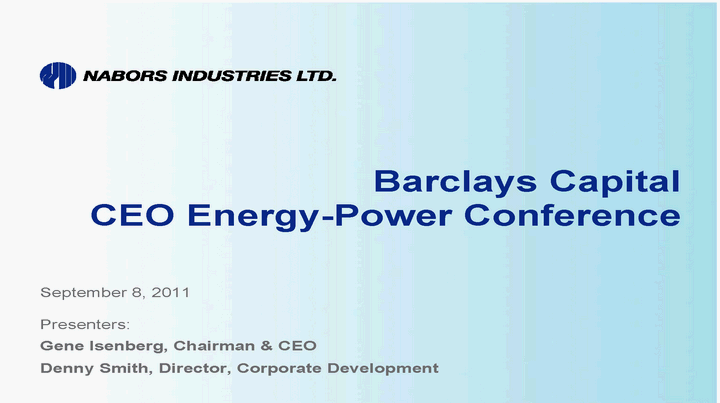
| Barclays Capital CEO Energy-Power Conference September 8, 2011 Presenters:Gene Isenberg, Chairman & CEO Denny Smith, Director, Corporate Development |
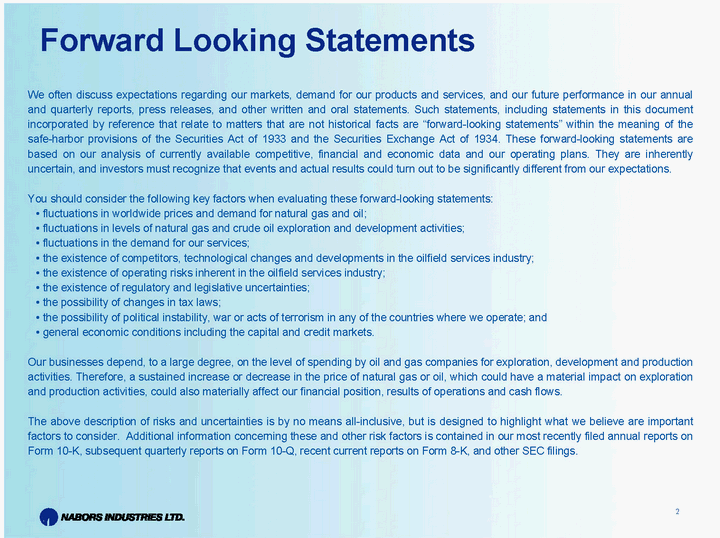
| Forward Looking Statements We often discuss expectations regarding our markets, demand for our products and services, and our future performance in our annual and quarterly reports, press releases, and other written and oral statements. Such statements, including statements in this document incorporated by reference that relate to matters that are not historical facts are “forward-looking statements” within the meaning of the safe-harbor provisions of the Securities Act of 1933 and the Securities Exchange Act of 1934. These forward-looking statements are based on our analysis of currently available competitive, financial and economic data and our operating plans. They are inherently uncertain, and investors must recognize that events and actual results could turn out to be significantly different from our expectations. You should consider the following key factors when evaluating these forward-looking statements:• fluctuations in worldwide prices and demand for natural gas and oil;• fluctuations in levels of natural gas and crude oil exploration and development activities;• fluctuations in the demand for our services;• the existence of competitors, technological changes and developments in the oilfield services industry;• the existence of operating risks inherent in the oilfield services industry;• the existence of regulatory and legislative uncertainties;• the possibility of changes in tax laws;• the possibility of political instability, war or acts of terrorism in any of the countries where we operate; and• general economic conditions including the capital and credit markets. Our businesses depend, to a large degree, on the level of spending by oil and gas companies for exploration, development and production activities. Therefore, a sustained increase or decrease in the price of natural gas or oil, which could have a material impact on exploration and production activities, could also materially affect our financial position, results of operations and cash flows. The above description of risks and uncertainties is by no means all-inclusive, but is designed to highlight what we believe are important factors to consider. Additional information concerning these and other risk factors is contained in our most recently filed annual reports on Form 10-K, subsequent quarterly reports on Form 10-Q, recent current reports on Form 8-K, and other SEC filings. 2 |
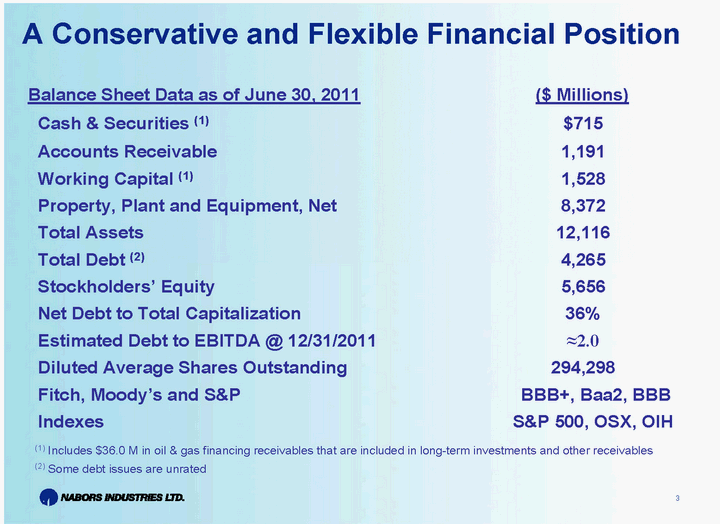
| A Conservative and Flexible Financial Position Balance Sheet Data as of June 30, 2011 ($ Millions) Cash & Securities (1) $715 Accounts Receivable 1,191 Working Capital (1) 1,528 Property, Plant and Equipment, Net 8,372 Total Assets 12,116 Total Debt (2) 4,265 Stockholders’ Equity 5,656 Net Debt to Total Capitalization 36% Estimated Debt to EBITDA @ 12/31/2011 2.0 Diluted Average Shares Outstanding 294,298 Fitch, Moody’s and S&P BBB+, Baa2, BBB Indexes S&P 500, OSX, OIH (1) Includes $36.0 M in oil & gas financing receivables that are included in long-term investments and other receivables (2) Some debt issues are unrated 3 |
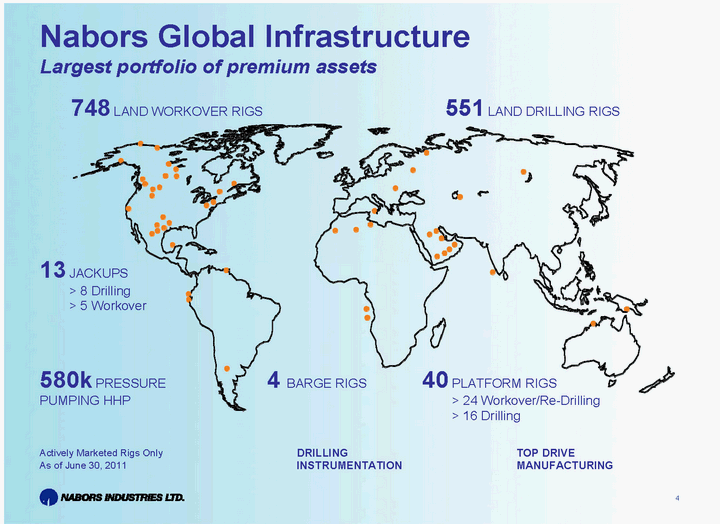
| Nabors Global InfrastructureLargest portfolio of premium assets748LAND WORKOVER RIGS551LAND DRILLING RIGS13JACKUPS > 8 Drilling > 5 Workover580kPRESSURE4BARGE RIGS40PLATFORM RIGS PUMPING HHP > 24 Workover/Re-Drilling > 16 Drilling Actively Marketed Rigs OnlyDRILLING TOP DRIVE As of June 30, 2011INSTRUMENTATION MANUFACTURING 4 |
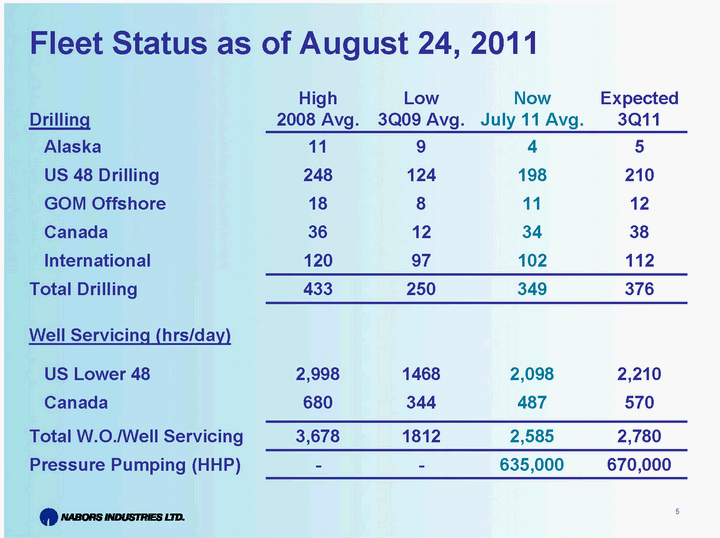
| Fleet Status as of August 24, 2011 High Low Now Expected Drilling 2008 Avg. 3Q09 Avg. July 11 Avg. 3Q11 Alaska 11 9 4 5 US 48 Drilling 248 124 198 210 GOM Offshore 18 8 11 12 Canada 36 12 34 38 International 120 97 102 112 Total Drilling 433 250 349 376 Well Servicing (hrs/day) US Lower 48 2,998 1468 2,098 2,210 Canada 680 344 487 570 Total W.O./Well Servicing 3,678 1812 2,585 2,780 Pressure Pumping (HHP) — - 635,000 670,000 5 |
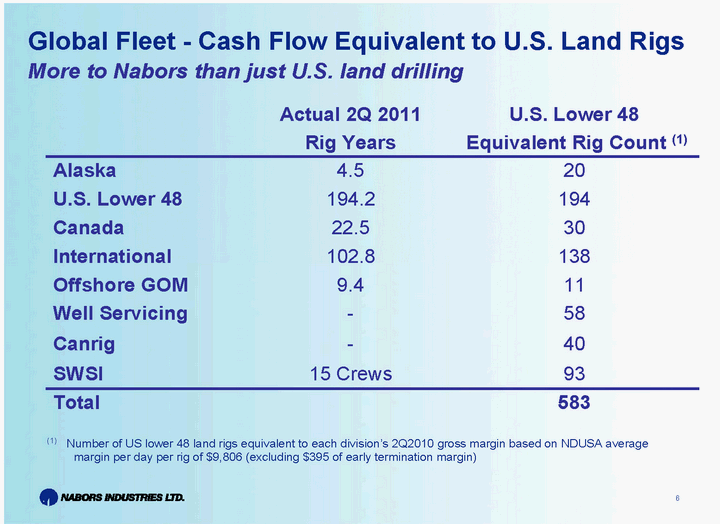
| Global Fleet — Cash Flow Equivalent to U.S. Land RigsMore to Nabors than just U.S. land drillingActual 2Q 2011 U.S. Lower 48 Rig Years Equivalent Rig Count (1) Alaska4.5 20U.S. Lower 48 194.2 194Canada22.5 30International102.8 138Offshore GOM9.4 11Well Servicing- 58Canrig- 40SWSI15 Crews 93Total 583 (1) Number of US lower 48 land rigs equivalent to each division’s 2Q2010 gross margin based on NDUSA average margin per day per rig of $9,806 (excluding $395 of early termination margin) 6 |
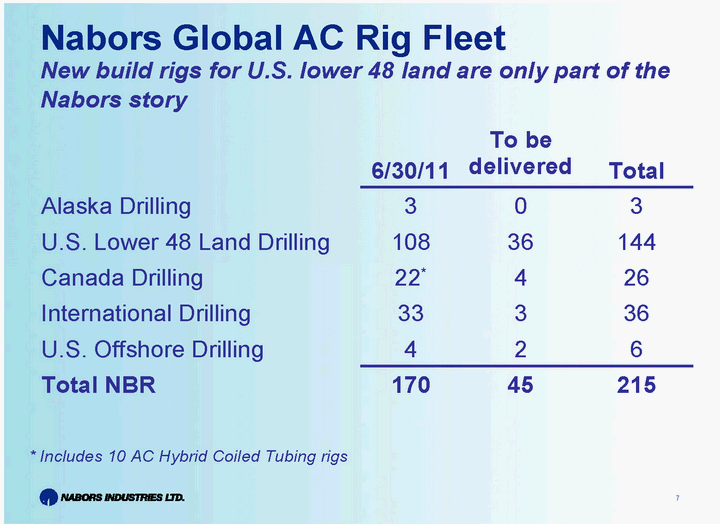
| Nabors Global AC Rig FleetNew build rigs for U.S. lower 48 land are only part of the Nabors storyTo be 6/30/11 delivered Total Alaska Drilling 3 0 3 U.S. Lower 48 Land Drilling 108 36 144 Canada Drilling 22* 4 26 International Drilling 33 3 36 U.S. Offshore Drilling 4 2 6Total NBR 170 45 215* Includes 10 AC Hybrid Coiled Tubing rigs 7 |
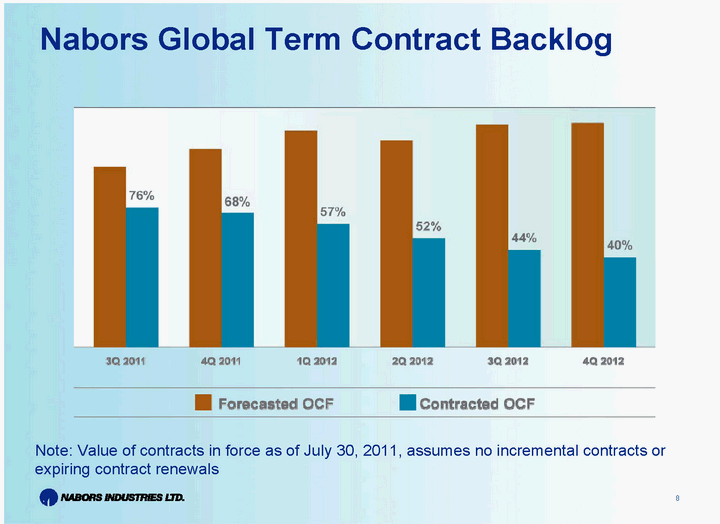
| Nabors Global Term Contract Backlog Note: Value of contracts in force as of July 30, 2011, assumes no incremental contracts or expiring contract renewals 8 |
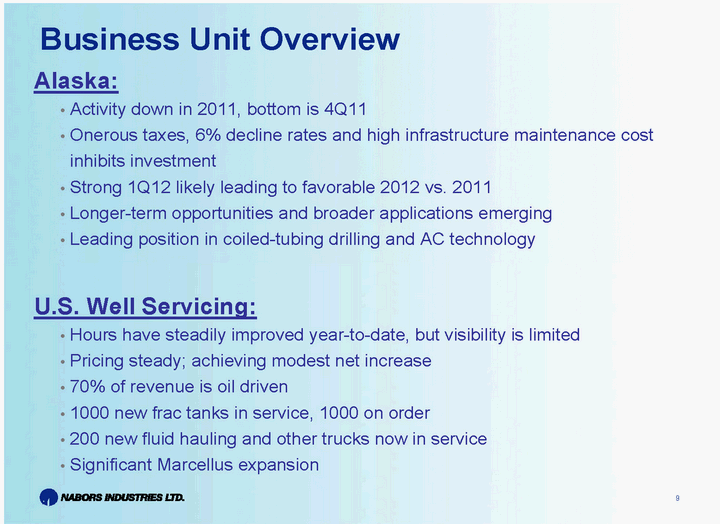
| Business Unit Overview Alaska:• Activity down in 2011, bottom is 4Q11• Onerous taxes, 6% decline rates and high infrastructure maintenance cost inhibits investment• Strong 1Q12 likely leading to favorable 2012 vs. 2011• Longer-term opportunities and broader applications emerging• Leading position in coiled-tubing drilling and AC technologyU.S. Well Servicing:• Hours have steadily improved year-to-date, but visibility is limited• Pricing steady; achieving modest net increase• 70% of revenue is oil driven• 1000 new frac tanks in service, 1000 on order• 200 new fluid hauling and other trucks now in service• Significant Marcellus expansion 9 |
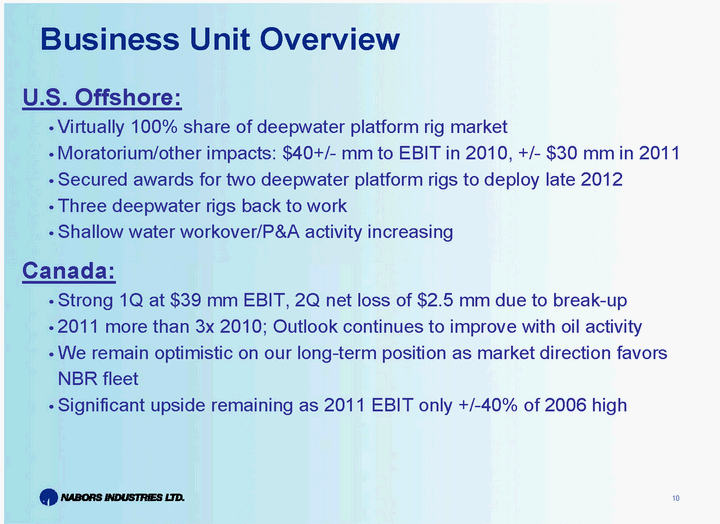
| Business Unit Overview U.S. Offshore:• Virtually 100% share of deepwater platform rig market• Moratorium/other impacts: $40+/- mm to EBIT in 2010, +/- $30 mm in 2011• Secured awards for two deepwater platform rigs to deploy late 2012• Three deepwater rigs back to work• Shallow water workover/P&A activity increasingCanada:• Strong 1Q at $39 mm EBIT, 2Q net loss of $2.5 mm due to break-up• 2011 more than 3x 2010; Outlook continues to improve with oil activity• We remain optimistic on our long-term position as market direction favors NBR fleet• Significant upside remaining as 2011 EBIT only +/-40% of 2006 high 10 |
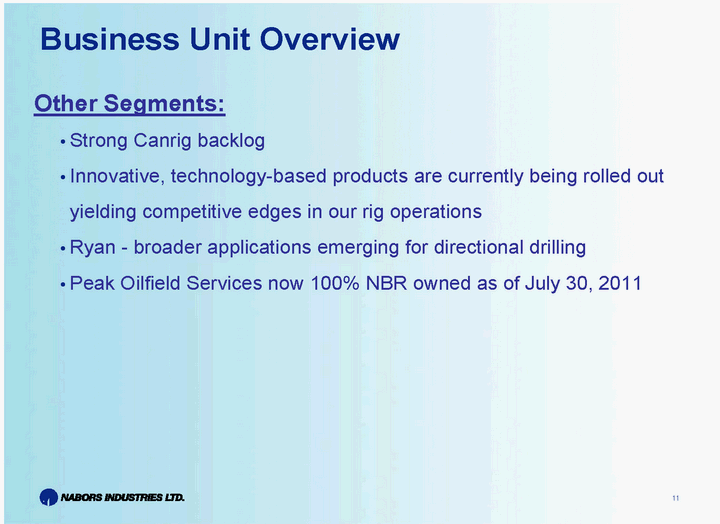
| Business Unit Overview Other Segments:• Strong Canrig backlog• Innovative, technology-based products are currently being rolled out yielding competitive edges in our rig operations• Ryan — broader applications emerging for directional drilling• Peak Oilfield Services now 100% NBR owned as of July 30, 2011 11 |
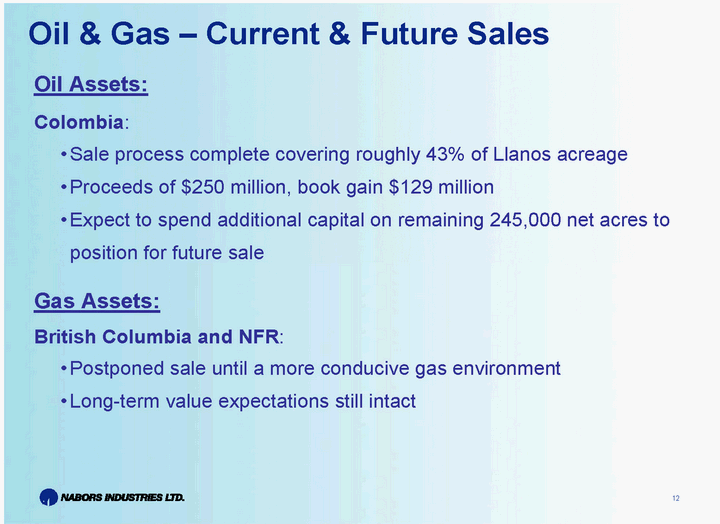
| Oil & Gas — Current & Future Sales Oil Assets: Colombia:•Sale process complete covering roughly 43% of Llanos acreage•Proceeds of $250 million, book gain $129 million•Expect to spend additional capital on remaining 245,000 net acres to position for future saleGas Assets: British Columbia and NFR:•Postponed sale until a more conducive gas environment•Long-term value expectations still intact 12 |
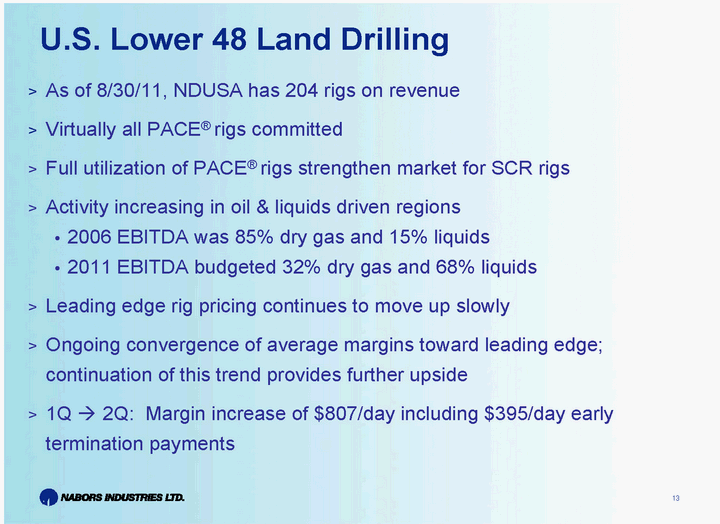
| U.S. Lower 48 Land Drilling > As of 8/30/11, NDUSA has 204 rigs on revenue > Virtually all PACE® rigs committed > Full utilization of PACE® rigs strengthen market for SCR rigs > Activity increasing in oil & liquids driven regions• 2006 EBITDA was 85% dry gas and 15% liquids• 2011 EBITDA budgeted 32% dry gas and 68% liquids > Leading edge rig pricing continues to move up slowly > Ongoing convergence of average margins toward leading edge; continuation of this trend provides further upside > 1QA2Q: Margin increase of $807/day including $395/day early termination payments 13 |
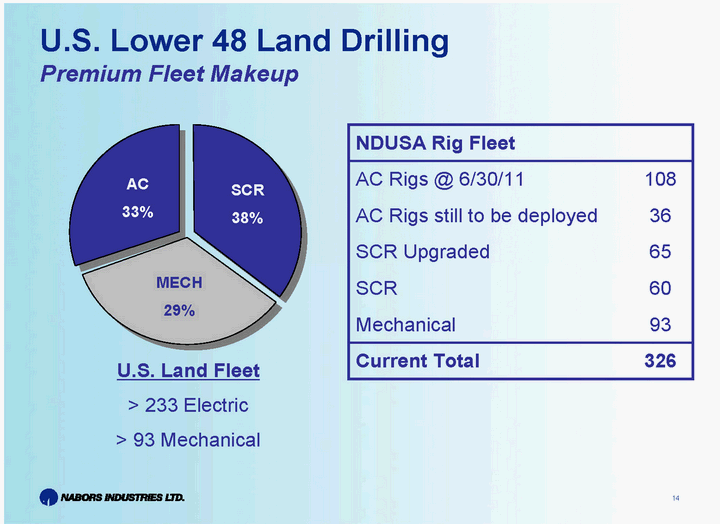
| U.S. Lower 48 Land DrillingPremium Fleet MakeupNDUSA Rig Fleet ACAC Rigs @ 6/30/11 108SCR 33% 38%AC Rigs still to be deployed 36 SCR Upgraded 65MECHSCR 6029% Mechanical 93Current Total 326 U.S. Land Fleet > 233 Electric > 93 Mechanical |
| 14 |
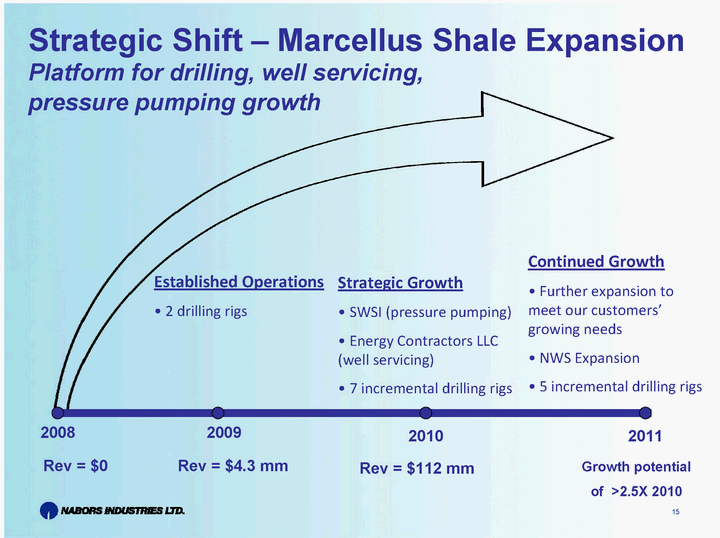
| Strategic Shift — Marcellus Shale ExpansionPlatform for drilling, well servicing, pressure pumping growthContinued Growth Established Operations Strategic Growth• Further expansion to• 2 drilling rigs• SWSI (pressure pumping) meet our customers’• Energy Contractors LLC growing needs (well servicing)• NWS Expansion• 7 incremental drilling rigs• 5 incremental drilling rigs2008 2009 2010 2011 Rev = $0 Rev = $4.3 mm Rev = $112 mm Growth potential of >2.5X 2010 15 |
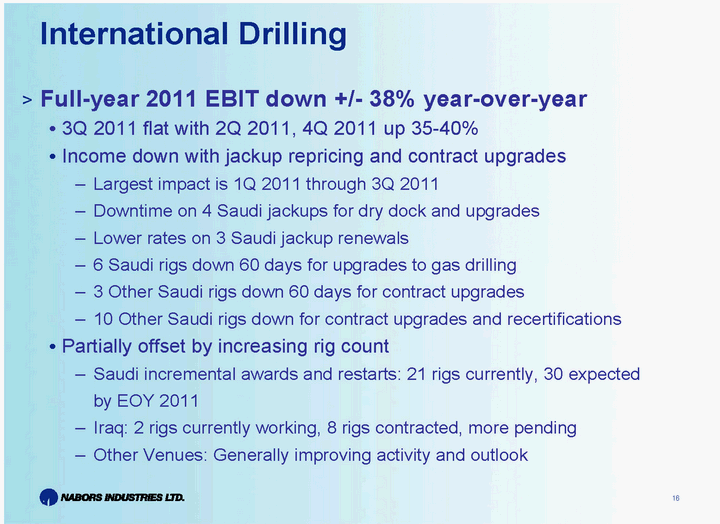
| International Drilling >Full-year 2011 EBIT down +/- 38% year-over-year• 3Q 2011 flat with 2Q 2011, 4Q 2011 up 35-40%• Income down with jackup repricing and contract upgrades — Largest impact is 1Q 2011 through 3Q 2011 — Downtime on 4 Saudi jackups for dry dock and upgrades — Lower rates on 3 Saudi jackup renewals — 6 Saudi rigs down 60 days for upgrades to gas drilling — 3 Other Saudi rigs down 60 days for contract upgrades — 10 Other Saudi rigs down for contract upgrades and recertifications• Partially offset by increasing rig count — Saudi incremental awards and restarts: 21 rigs currently, 30 expected by EOY 2011 — Iraq: 2 rigs currently working, 8 rigs contracted, more pending — Other Venues: Generally improving activity and outlook 16 |
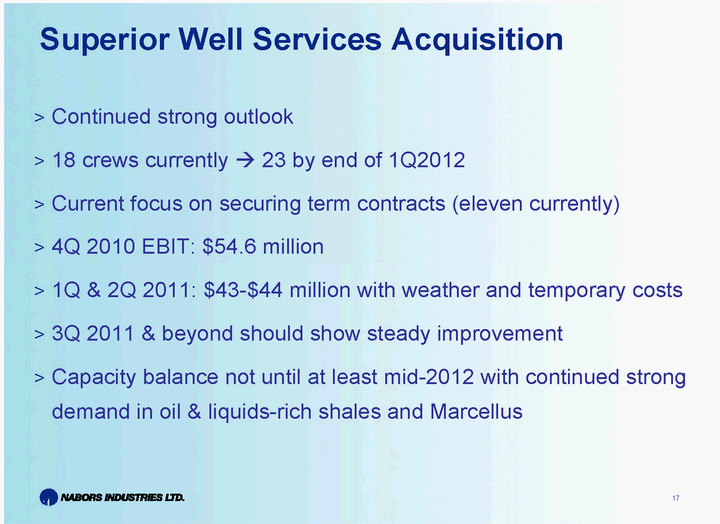
| Superior Well Services Acquisition > Continued strong outlook > 18 crews currentlyA23 by end of 1Q2012 > Current focus on securing term contracts (eleven currently) > 4Q 2010 EBIT: $54.6 million > 1Q & 2Q 2011: $43-$44 million with weather and temporary costs > 3Q 2011 & beyond should show steady improvement > Capacity balance not until at least mid-2012 with continued strong demand in oil & liquids-rich shales and Marcellus 17 |
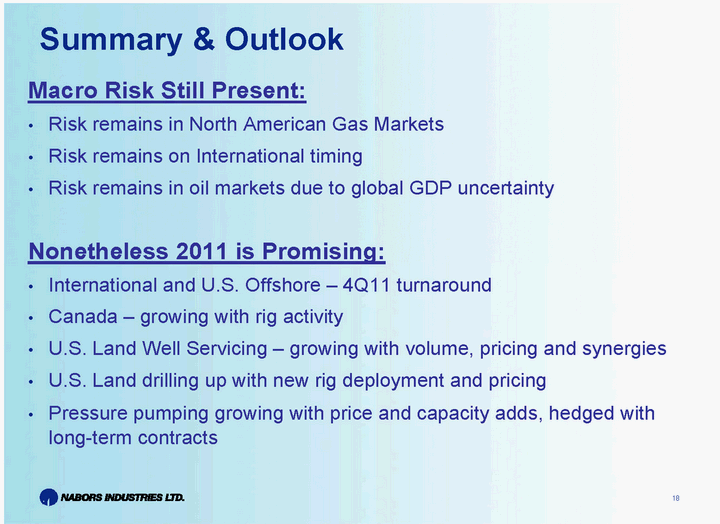
| Summary & Outlook Macro Risk Still Present:• Risk remains in North American Gas Markets• Risk remains on International timing• Risk remains in oil markets due to global GDP uncertaintyNonetheless 2011 is Promising:• International and U.S. Offshore — 4Q11 turnaround• Canada — growing with rig activity• U.S. Land Well Servicing — growing with volume, pricing and synergies• U.S. Land drilling up with new rig deployment and pricing• Pressure pumping growing with price and capacity adds, hedged with long-term contracts 18 |
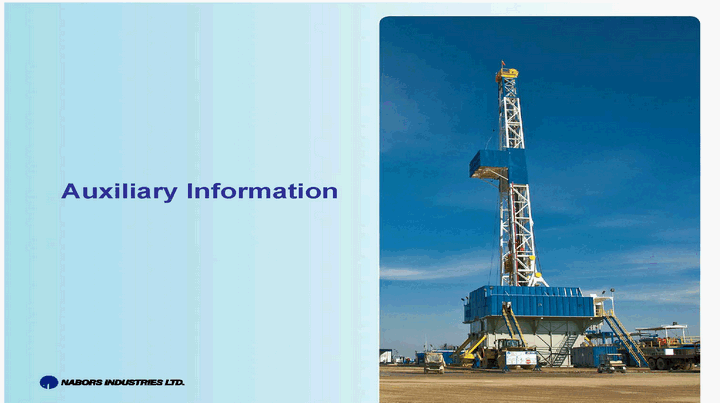
| Auxiliary Information |
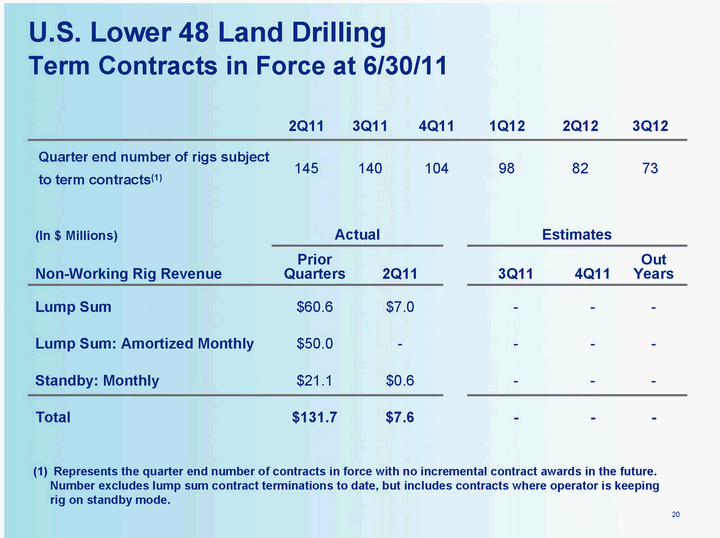
| U.S. Lower 48 Land Drilling Term Contracts in Force at 6/30/11 2Q11 3Q11 4Q11 1Q12 2Q12 3Q12 Quarter end number of rigs subject 145 140 104 98 82 73to term contracts(1) (In $ Millions) Actual Estimates Prior Out Non-Working Rig Revenue Quarters 2Q11 3Q11 4Q11 Years Lump Sum$60.6 $7.0 — - -Lump Sum: Amortized Monthly$50.0 — - — -Standby: Monthly$21.1 $0.6 — - -Total $131.7 $7.6 — - - (1) Represents the quarter end number of contracts in force with no incremental contract awards in the future. Number excludes lump sum contract terminations to date, but includes contracts where operator is keeping rig on standby mode. 20 |
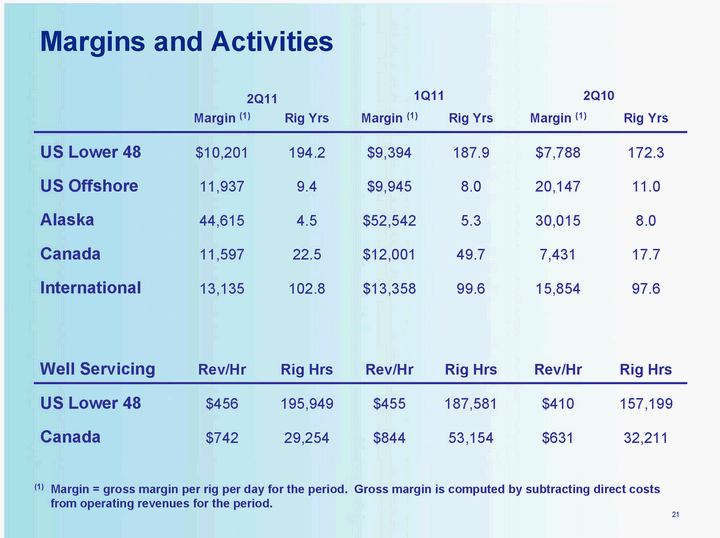
| Margins and Activities 2Q11 1Q11 2Q10 Margin (1) Rig Yrs Margin (1) Rig Yrs Margin (1) Rig Yrs US Lower 48$10,201 194.2 $9,394 187.9 $7,788 172.3US Offshore11,937 9.4 $9,945 8.0 20,147 11.0Alaska44,615 4.5 $52,542 5.3 30,015 8.0Canada11,597 22.5 $12,001 49.7 7,431 17.7International 13,135 102.8 $13,358 99.6 15,854 97.6Well Servicing Rev/Hr Rig Hrs Rev/Hr Rig Hrs Rev/Hr Rig Hrs US Lower 48$456 195,949 $455 187,581 $410 157,199Canada$742 29,254 $844 53,154 $631 32,211(1) Margin = gross margin per rig per day for the period. Gross margin is computed by subtracting direct costs from operating revenues for the period. 21 |
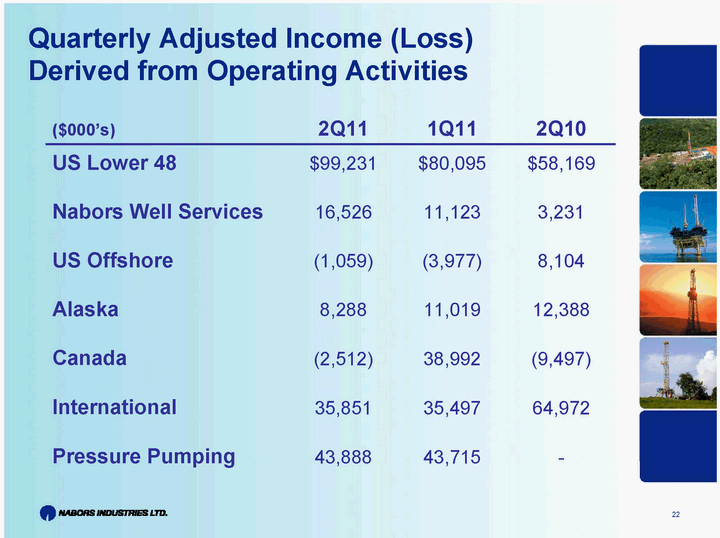
| Quarterly Adjusted Income (Loss) Derived from Operating Activities ($000’s) 2Q11 1Q11 2Q10 US Lower 48$99,231 $80,095 $58,169Nabors Well Services16,526 11,123 3,231US Offshore(1,059) (3,977) 8,104Alaska8,288 11,019 12,388Canada(2,512) 38,992 (9,497)International35,851 35,497 64,972Pressure Pumping43,888 43,715 - 22 |
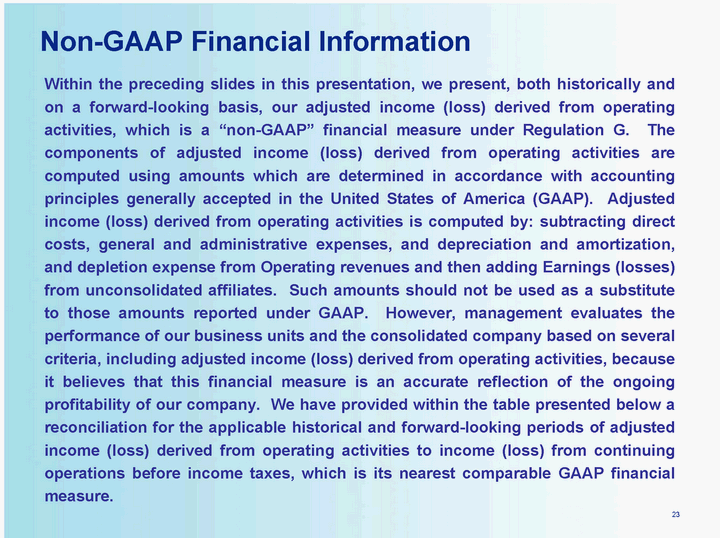
| Non-GAAP Financial Information Within the preceding slides in this presentation, we present, both historically and on a forward-looking basis, our adjusted income (loss) derived from operating activities, which is a “non-GAAP” financial measure under Regulation G. The components of adjusted income (loss) derived from operating activities are computed using amounts which are determined in accordance with accounting principles generally accepted in the United States of America (GAAP). Adjusted income (loss) derived from operating activities is computed by: subtracting direct costs, general and administrative expenses, and depreciation and amortization, and depletion expense from Operating revenues and then adding Earnings (losses) from unconsolidated affiliates. Such amounts should not be used as a substitute to those amounts reported under GAAP. However, management evaluates the performance of our business units and the consolidated company based on several criteria, including adjusted income (loss) derived from operating activities, because it believes that this financial measure is an accurate reflection of the ongoing profitability of our company. We have provided within the table presented below a reconciliation for the applicable historical and forward-looking periods of adjusted income (loss) derived from operating activities to income (loss) from continuing operations before income taxes, which is its nearest comparable GAAP financial measure. 23 |
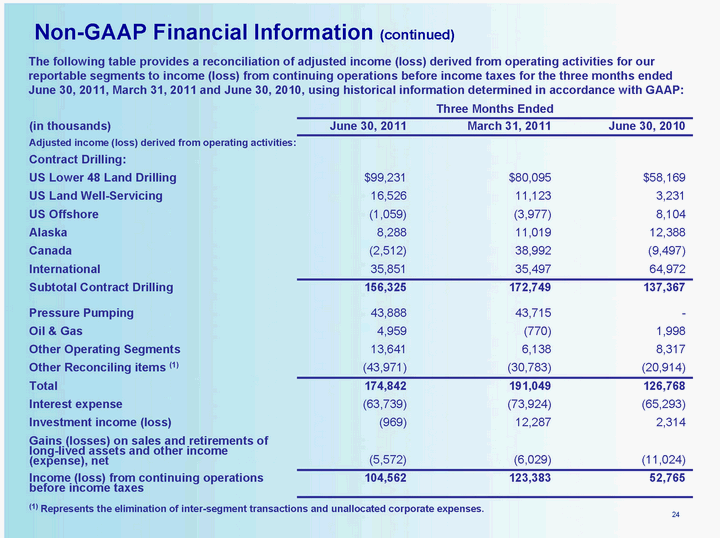
| Non-GAAP Financial Information (continued) The following table provides a reconciliation of adjusted income (loss) derived from operating activities for our reportable segments to income (loss) from continuing operations before income taxes for the three months ended June 30, 2011, March 31, 2011 and June 30, 2010, using historical information determined in accordance with GAAP: Three Months Ended (in thousands) June 30, 2011 March 31, 2011 June 30, 2010 Adjusted income (loss) derived from operating activities: Contract Drilling: US Lower 48 Land Drilling$99,231 $80,095 $58,169US Land Well-Servicing16,526 11,123 3,231US Offshore(1,059) (3,977) 8,104Alaska8,288 11,019 12,388Canada(2,512) 38,992 (9,497)International35,851 35,497 64,972Subtotal Contract Drilling 156,325 172,749 137,367 Pressure Pumping43,888 43,715 -Oil & Gas4,959 (770) 1,998Other Operating Segments13,641 6,138 8,317Other Reconciling items (1)(43,971) (30,783) (20,914)Total 174,842 191,049 126,768 Interest expense(63,739) (73,924) (65,293)Investment income (loss)(969) 12,287 2,314Gains (losses) on sales and retirements of long-lived assets and other income (expense), net(5,572) (6,029) (11,024)Income (loss) from continuing operations 104,562 123,383 52,765 before income taxes (1) Represents the elimination of inter-segment transactions and unallocated corporate expenses. 24 |